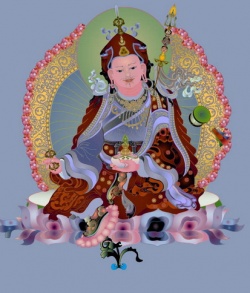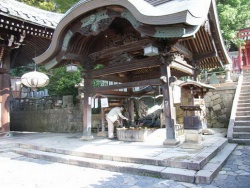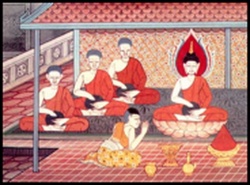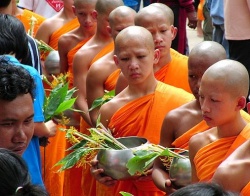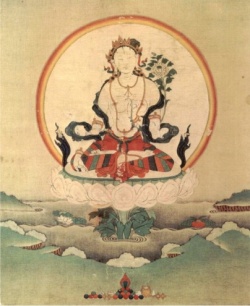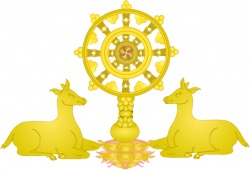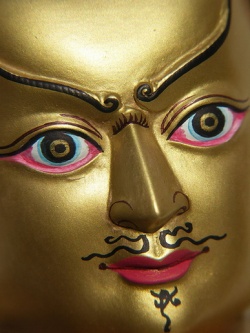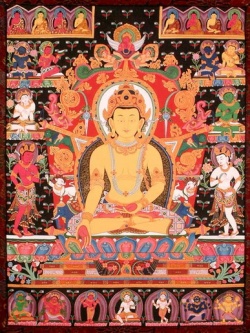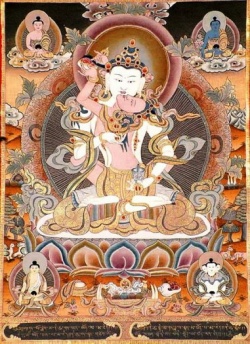Tibet and Neighboring Areas
</poem> The first discernible phase of the transmission of Indian Buddhism to the isolated Himalayan plateau of Tibet occurred during the period from 620 to 866 c.e. At that time, the first great Tibetan empire was established and ruled by the Yarlung dynasty. King Songsten Gampo, who was the founder of this dynasty, took two closely related actions that set the process in motion. He became a staunch supporter of Buddhism (which by that time had become the dominant religious and intellectual tradition across much of Asia), and he sent emissaries to India who developed a script used to commit the Tibetan language to writing. In the two centuries that followed, the Buddhist cause in Tibet was significantly advanced through the support of subsequent rulers and also through the activities of Buddhist practitioners from India. The most famous of these was a monk named Padmasambhava, who has been remembered as the patron saint of Tibetan Buddhism, as the great miracle worker who quelled the local demons, and as the founder of an important Esoteric sect (Nyingma Pa) that has played a major role throughout Tibetan Buddhist history.
The demise of the Yarlung dynasty in the mid ninth century constituted a setback for the Buddhist cause in Tibet. Yet the process of transmission and transformation continued until the early thirteenth century, when the final collapse of Buddhism in India coincided with the establishment of a Buddhist theocracy in Tibet. This continuing process of transmission and transformation involved a massive amount of translation through which an amazing number of Buddhist texts of all kinds (Hinayana, Mahayana, and Esoteric) were rendered from Sanskrit into Tibetan.
It also involved a major reformmovement that was nurtured by Indian monks and that led to the formation of several new Esoteric/ Vajrayana sects. These included the Sakya Pa, the Kadam Pa, and the Kagyu Pa sects, which rejected some of the more unconventional practices associated with Padmasambhava and the Nyingma Pa tradition. On the religio-political front, this process involved the forging of an alliance between the powerful Mongol forces, which were in the process of conquering much of Asia, and the Sakya Pa monks, who, in the thirteenth century, assumed responsibility for governing a significant area of the Tibetan plateau. The Sakya Pa theocracy ruled Tibet from 1216 to 1354, when it was replaced by a secular regime.
Between the thirteenth and the mid twentieth centuries, Tibetan Buddhists maintained their religious dominance in Tibet, continued the process of establishing their version of Buddhism among the Mongols, and extended their Buddhist tradition to surrounding Himalayan areas as well. In the specifically religious arena the major development was a fifteenth-century reform that led to the establishment of the Geluk Pa monastic sect.
This sect was renowned for its scholarship and was more stringent than the other Tibetan sects in its observance of the traditional monastic discipline and in its insistence on Mahayana doctrinal training as a preparation for and accompaniment to tantric techniques and practices. Further, during this medieval period, the Tibetans developed a unique leadership system based on a very distinctive theory of reincarnation. Soon after a religious leader died he was considered to be reborn as an infant who was identified by the community as the reincarnation of the deceased leader. This child was appropriately trained and then, at the proper time, assumed the leadership role that his predecessor had held.
In the religio-political sphere the main development during the late medieval period occurred in the mid seventeenth century when a Mongol army led by Gushri Khan conquered Tibet. After his military victories, Gushri Khan turned the administration of the country over to a Tibetan leader of the Geluk Pa sect who had previously served as his personal religious advisor. This Geluk Pa monk was the Dalai Lama, who was recognized as the fifth in a series of Dalai Lamas who were taken to be the successive reincarnations of the bodhisattva Avalokitesvara. The Geluk Pa theocracy that was established at this time continued to rule the country until 1959, when the fourteenth Dalai Lama was forced by the Chinese invasion to flee from Tibet and to take refuge in India.
17. It could be argued that the relevant area should be expanded to include other regions in the so-called Western world, particularly the United Kingdom, France, and Australia. However, focusing on North America (more specifically on the United States and Canada) makes it possible to characterize distinctive elements with greater specificity. The Chinese invasion and the Chinese annexation of Tibet marked a radical turning point in the history of Tibetan Buddhism. Within Tibet itself the persecution of Buddhism that was perpetrated by the Chinese. particularly during the course of the great Cultural Revolution in the 1960s.was devastating. However, despite the physical and institutional destruction that has been wrought, much of the Tibetan population has remained steadfastly loyal to Buddhism. Buddhism has, in fact, become a rallying point for Tibetan resistance to Chinese control and oppression. Outside the country, the Dalai Lama has maintained leadership of a large diaspora community made up of Tibetan refugees who have settled primarily in India and in many parts of the Western world as well.
Expansion in the West
Having completed our historical discussion of the development of the distinctive Buddhist cultures that developed in the pan-Asian realm, there remains a concluding question worthy of consideration. That question is whether there has developed in the late nineteenth and twentieth centuries in North America a fourth branch of Buddhist culture that should be considered as at least a junior partner alongside the other three.17 Buddhist immigrants from each of the three Buddhist cultural areas that we have already discussed have established a strong Buddhist presence in both Canada and the United States. A steadily increasing number of North Americans who do not have an Asian background, including members of the artistic and intellectual elites, have taken up the practice of Buddhism.
A great many Buddhist texts (including Hinayana, Mahayana, and Esoteric texts) have been translated into English. Original Buddhist materials are now being written by North American practitioners who publish their work in English; and in many Buddhist communities in Canada and the United States, English has become the primary language not only for religious instruction but for liturgical purposes as well. Perhaps the most important fact is that distinctively North American emphases have begun to emerge in the areas of doctrine, practice, and community life. These emphases include, for example, a strong ecumenical concern, a special interest in interreligious dialogue, a heavy focus on certain meditational practices, and a deep commitment to social activist causes. Taken together these various developments demonstrate that the question concerning the emergence of a distinctively North American tradition of Buddhism is both relevant and important, and they also suggest that in the not-toodistant future an affirmative answer may be justified.
Temples, Sacred Objects, and Associated Rituals
The essay in this chapter was taken from James Bissett Pratt, The Pilgrimage of Buddhism and a Buddhist Pilgrimage (New York: Macmillan, 1928), 503 .12. Courtesy of AMS Press.
Temples and Monastic Complexes (Japan)
Temples and monastic complexes have long formed a fundamental component of Buddhist religious expression and practice. They have contained highly segregated halls for monastic living, meditation, and study. They have also contained other halls, edifices, artistic representations, and images for devotional expression of a more inclusive character. Buddhist temples and monasteries have served as a primary locus for collective rites and ceremonies. Among the most important of these rites and ceremonies are monastic legal proceedings (such as higher and lower ordinations) and procedures in which the laity takes moral precepts (for example, not to kill, lie, and steal). Others include annual community fairs and celebrations, especially those surrounding the lives and deeds of Buddha(s) and bodhisattvas.
Finally, there are also daily prayers and petitions to the Buddha(s), bodhisattvas, and hosts of other supernaturally powerful beings that seek to draw upon the powers of these beings to assuage a range of day-to-day problems and concerns. These problems and concerns include, among others, illness, financial troubles, disruptions in the natural world such as droughts and floods, and anxieties concerning personal relationships and the stability of the social and political order.
Buddhist temples and monastic complexes (and the monks who live in them, manage their upkeep, and oversee their daily and annual rites and ceremonies) have traditionally been focal points for significant and often elaborate acts of lay piety and generosity. These acts have been crucial to the survival and social prestige of Buddhist temples and monastic complexes by providing them with the material and cultural resources to develop as centers of religious, artistic, and cultural creativity. At least two basic features of the Buddhist tradition as a whole motivate laypeople to give to temples and monastic complexes.
First, temples and monastic complexes provide access to potentially efficacious sacred power and authority. Such sacred power and authority consist of supernatural blessing and protection, provided by Buddhas, bodhisattvas, gods, goddesses, and other supernatural beings. Or they may more simply manifest in wise counsel given by a well-known or respected monk. Second, and closely related, temples and monastic complexes provide an important context for the generation of a specific type of spiritual quality, merit Making merit, a rather ubiquitous concern in most Buddhist practices, helps one attain a better rebirth and also, ultimately, to attain a state of rebirth and/or mind necessary for liberation from the cycle of rebirth.
Generating merit may occur in various ways. For instance, practitioners may simply listen to sermons and stories of the Buddhafs life, thereby becoming mentally calmed. Or they may provide the financial and material resources for temples, monasteries, and the monks associated with them. Significantly, Buddhist temples, monastic complexes, and their respective monks are depicted as the most efficacious sources for the cultivation of merit. This is not surprising, since these institutions and individuals are the primary loci for the maintenance and propagation of Buddhism itself.
Thus, it is appropriate to begin our survey of the life of Buddhism with a descriptive account of Buddhist temples and the activities associated with them. The setting of this first essay is Japan in the first quarter of the twentieth century, and the observer is, at times, overly romantic. However, his descriptions convey the kind of complexity and diversity that has been (and still remains) characteristic of sacred sites and activities throughout the Buddhist world.
James Bissett Pratt
If the pilgrim to Japan makes Kyoto his first stop, his attention immediately upon alighting from the train will be called to the great roofs of the Higashi Hongwanji, the immense temple of the Shin sect near the
1. Editorsf note: Amida is a Buddha who is especially prominent in Pure Land traditions. 2. Editorsf note: Lohans are the semidivinized saints of the Chinese Buddhist pantheon.
station. The majority of Buddhist temples in Japan follow the Chinese custom of facing south; but there are exceptions aplenty, and this is one of them. Like many Shin temples, it faces the east. Three monumental portals pierce the front wall of the sacred enclosure, the central one a gigantic gateway with a high double roof, rich with elaborate carving. Passing through the portals, one finds oneself in a spacious court. A small shrine is at onefs left, with a kind of pavilion before it in which a few old or weary people are always to be found, resting in the shade and chatting pleasantly with their neighbors. Beyond this is the southern gateway and a bell tower. A fountain is playing in the court, made in the form of a huge lotus bud, and in another place there is a large bowl with running water, roofed over for the protection of pilgrims who often wash here before worshiping. One sees also a few large bronze lanterns.
But at first these things are hardly noticed, for onefs eyes turn irresistibly toward the two great halls on the western side of the court. The northern and larger of these is the hondo, or founders hall, with a double roof, and the smaller Amida-do, to the south, with a single roof, is connected with the larger building by a covered corridor.1 Along this corridor are piled several huge coils of rope, many inches in thickness and made of human hair, donated for the purpose by zealous Buddhist women at the time of the building of the temple. It was with these ropes that the great beams of the temple were carried and hoisted into place.
The roofs of both the main halls are too high and steep to give that sense of perfect proportion which the earliest Japanese temples possess; but the curve of the roofs and the tilt of the eaves, rather less pronounced than those of Chinese temples, are exceedingly graceful. And what the exterior lacks in beauty, as compared with the few extant specimens of early Japanese architecture, is more than atoned for by the impressiveness of the interior.
To one whose acquaintance with Buddhist temples is confined to China and Korea, these great Shin temple interiors will come as a revelation. Here no confusion of tawdry decoration and cheap votives, no burning of paper money or even of incense, no dirty floors or fantastic Lohan just a great, cathedral-like open space (in this case 42 by 66 feet) covered with matting and immaculately clean, a rail dividing the hall into two unequal parts, and behind it a rich but not confusing al
3. Editorsf note: Readers should be aware that more recent scholarship has shown that this temple was actually founded and built in 1665, or shortly thereafter. 4. Editorsf note: Indra and Brahma are originally Indian deities shared with Hinduism. 5. It is a popular belief that one may tell whether or not onefs prayer to the Ni-O will be answered by chewing a bit of paper, making it into a gspit-ball,h and throwing it at the wire grating. If it sticks, the prayer has been heard. tar, and a single image, executed in exquisite taste. The standing Amida in the Amida-do is particularly beautiful and reminds one at once of the Madonna in some Italian cathedral.
The worshipers, as well as the building, present a striking contrast to those one has become accustomed to in China. As I have said, there is here no burning of paper money, no fortune-telling, but just little groups of silent, earnest worshipers, coming in, kneeling a few moments before the shrine in earnest prayer, and silently departing. The whole atmosphere of the place is unmistakably religious; and he who cannot worship his God (whatever that may mean to him) in this shrine of Amida must, I think, be somehow lacking in spiritual susceptibility.
The Higashi Hongwanji Temple of Kyoto is typical of nearly all the large temples of the Shin sect and fairly representative of many Jodo temples as well. It can hardly be said to represent all Japanese Buddhist temples, for the Buddhist temples of Japan have no such regularity of plan as that one finds in most Chinese temples. So far as I know there is only one Japanese temple laid out on the regular Chinese plan.the large headquarters of the Obaku division of the Zen sect at Uji, built in 1650 by Chinese Buddhists and kept for many years after its founding in the hands of Chinese monks.
3 Some of the larger Zen and Shingon temples, while not following at all strictly the Chinese pattern, follow the general scheme of having a large portal, with guardian gods, and back of it, in a spacious enclosure, a succession of two or three large temple-halls, with the buildings for the monks at the rear and on the sides. This, however, is not very common, and, as I have said, there is no regular plan for either the exterior or the interior of a Japanese temple. Yet certain things are fairly constant. Most constant of all, perhaps, is the universal cleanliness and excellent repair.a characteristic of nearly every temple I have visited in Japan.
Nearly all Buddhist temples have a court or enclosure, though I have seen one or two without anything of the kind. The enclosure is usually entered through a roofed gateway in which are often enshrined the gigantic and terrible Ni-O.the two Devas, Indra and Brahma.4 These are genuine objects of popular worship, as the many little gspit-ballsh of paper sticking to the wire netting in front of the gods clearly show.5 In place of the Ni-O one may
6. Editorsf note: The Kings of the Four Quarters are considered to be defenders of the dharma; they are found in South Asian contexts as well. 7. There are two forms of torii, one with straight cross beams and of rather ponderous appearance, the other much more graceful, with cross beams that have swaying lines and an upward tilt at the ends. The straight and ponderous kind is thought to be the more ancient form, while the graceful type is by far the more popular. The archaic style of torii is found only at a few Shinto shrines (never at Buddhist temples) and is always the token of a self-conscious effort to revert to pure Shinto uncontaminated with Buddhist or Chinese influence.
8. Editorsf note: See the general introduction. find the Kings of the Four Quarters, so familiar in Chinese and Korean contexts.6
Sometimes the temple enclosure is entered through a torii (of the more artistic and less archaic variety),7 borrowed, of course, from Shinto in the days before the rise of the Meiji government, when the two religions were practically one.8 Sometimes just within the gateway is a tiny Shinto shrine, especially in the temples of the Shingon and Nichiren sects. There may also be a pagoda (reliquary), with two, three or five stories. In some temple grounds, especially in those of the Shingon sect, one will find a sotoba or stone monument made up of five parts, symbolizing the five material elements.
The lowest part is a cube or another solid shape with six faces (each face being a parallelogram) signifying earth; the second a sphere signifying water; the third a cone with broken apex, signifying fire; the fourth a crescent signifying air or wind; and the uppermost a ball ending in a tip or flame-like point, signifying ether. A few temples have, in some part of their grounds, a peculiar cylindrical metal column known as a sorinto. The upper part of the shaft is surrounded with nine metal rings and usually surmounted with a lotus carrying a pointed ball, like that on the summit of the sotoba.
The court or enclosure of a Buddhist temple is one of the loveliest things in Japan. The stone lanterns, the ancient pine trees, the wonderfully wrought brazen dragons that spout water in a fountain, the stone Jizo (a bodhisattva), wrapped about with votive cloths presented by devout worshipers whose little children have gone to the far land where now only Jizo can help them, the bell tower, the facade of the temple itself with perhaps half a dozen smaller structures standing about it, the lotus pond with its gold fish, the many pigeons that fly about the court, owing their living to the kindness of the pilgrims, and most of all, the glad looks of the worshipers who have come in their best kimonos to do homage to the Buddha, and the joyous faces of the many children almost invariably found here, make it a scene not to be forgotten. For the temple courts are the playgrounds of Japan. They do not merely happen
9. In the Shi-Tenno temple at Osaka the ashes of the dead are sometimes mixed with clay and made into small Buddha images, which are deposited in one of the shrines, a rather striking symbolization of the hope that the departed one has become Buddhato be playgrounds. The children are desired. Many temple courts are provided with swings and various simple games; and the children love the place and learn thus early to associate religion with delight. A very large proportion of the men and women of Japan must look back upon some Buddhist temple as the scene of their happiest hours.
Besides the children there are tired mothers with their babies on their backs, and weary people of various ages. Some have come here with their grandchildren to watch them play, some have come for an hourfs chat with old friends, in the shade of a great tree or beside the fountain; some, still in the midst of lifefs work, have fled here for a momentfs refreshment and worship, spent in part before the calm image of Amida in the shrine, in part out here in the fresh air of the courtyard filled with the cooing of doves and the shouts of children.
Many of the tenderest memories and most significant moments of life thus cluster round the Buddhist temple. Not only the children but at times people of all ages find the temple court a kind of playground. Many a temple has a monthly fair, when for a whole night the sacred enclosure is luminous with colored lanterns and filled with booths at which you can buy all sorts of pretty things, and the air is musical with the notes of the temple gong, the chanting of priests, and the voices of young people.
But the temple enters also and of course into the solemn hours. Here the funeral service is held, and the memorial service for the dead. Here the tablets of many of the departed are preserved and sometimes a portion of their ashes,9 and around many a Buddhist temple lies the ancient gchurchyardh as we should call it.its gray stones clustering about the sacred walls, just as they so often do in New England.and Old England.
The main hall of the temple, in some of the Buddhist sects, is not infrequently closed. But except at night the temple enclosure, and at least one of its shrines, central or subordinate, is always open, and worshipers enter and depart during any hour of daylight. If one is tempted to criticize the enormous amount of capital that has been expended on Buddhist temples in Japan, saying that all this money might have been invested in more profitable ways, this answer may be at least given that hardly anything in Japan is in more constant use than her temples.
The temple proper.the building itself as well as all the subordinate buildings belonging to it.is, like everything else in Japan, made of wood.of wood and paper. Frequently portions of the roof and ends of the overhanging beams are elaborately carved. There is usually no great front door, as in Chinese temples, but just many sliding screens, mostly of paper. A familiar figure just outside the door of many of the larger temples is Binzuru, one of the sixteen Rakans (semidivinized saints), who, the story goes, once looked after a woman too curiously and thereafter was forbidden to enter the sacred building. This punishment (or was it his sin?) seems to have resulted in making him more popular than all his brethren.
Tradition has endowed him.or his image.with a miraculous power of healing. The worshiper who is ill has only to rub his hand upon the part of Binzurufs image corresponding to the diseased part of his own body and then to rub his hand upon the infirm member; if he does this with sufficient faith he will be healed. So firmly planted is this belief in large numbers of temple visitors, that the legs and arms of most Binzuru images are half rubbed away. The Binzuru at the Asakusa temple in Tokyo has healed so many parts of so many ailing bodies that there is hardly anything left of the poor fellow.
The government at times has had to lock up the Binzuru images to prevent the spread of disease through their miraculous touch. The other Rakans are seldom seen. There are two or three temples in Kyoto, and one in Nagoya where they are carved in the round though of smaller size and less fantastic in shape than in China, and so far as I know they never (except at Obakusan) occupy the position in the central temple which Chinese custom assigns them. Usually one sees them, if at all, represented not in carving but painted upon vertical scrolls, hung up in the exhibition rooms of the temple, or (quite as often) in some museum. For the Rakans in Japan are of antiquarian and artistic interest chiefly and (except for Binzuru) form no part of the real life of the religion.
The interior of the temple is arranged in various ways with little that is absolutely uniform. There is, of course, always a central shrine or throne.more commonly a shrine with doors that may be, and often are, closed. Within this shrine (or on the throne if there be one) usually sits or stands an image of one of the Buddhas, Bodhisattvas, or founders, although a tablet may be substituted for the image, bearing a name upon it, or (as in some Shin temples) the sacred formula Namu Amida Butsu. As I have indicated, the shrine is quite frequently closed and the image may be shown only at certain times of the day or, it may be, only at intervals of many years.
In front of the shrine stands the altar, a long and narrow table which usually contains a large incense burner in the middle, two candlesticks, one on each side, and at each end a spray of lotus leaves gracefully carved of wood and gilded. The candlesticks may be of brass or lacquer; the incense burner is usually of bronze, though it may be of lacquer or of porcelain.
Usually the altar contains little or nothing else besides these five things, though at times one finds it crowded with offerings of food, flowers, and candles, as in China. Among the votives frequently placed on or near the altar (sometimes in the shrine itself ), the Shinto mirror is not uncommon. In the larger temples there are usually two subordinate shrines at the right and left of the central shrine and further back.close up against the rear wall. These are usually sacred to Kwannon or Jizo, or Fudo or Monju, or to the founder of the sect or some distinguished abbot; or one of them may be devoted wholly to the tablets of the dead.
Besides the shrines and altars I have mentioned, a Buddhist temple may contain all sorts of things; and in fact its irregularity of plan and the almost endless variety which it may present constitute a large part of its unfailing fascination. In a large and popular city temple like that of the Shi-Tenno in Osaka there are any number of little side shrines to all sorts of Buddhist and Shinto nobility (if I may use the phrase), with votives of every kind from the odd to the pathetic.from pictures of mothers with breasts spouting streams of milk, to little kimonos that once belonged to children now dead, and presented by their parents to Jizo in the hope that somehow he may clothe them. Many Buddhist temples have long rows of show apartments which are in fact museums and in which are to be seen some of the choicest specimens of Japanese painting at its best.
All monastic temples of course possess dormitories and a refectory, and most of them have offices as well. The larger temples thus form a maze of buildings, with hundreds of occupants. Sometimes one finds a round or octagonal building erected to house the Buddhist scriptures. Occasionally these round library buildings are so constructed as to revolve when sufficient force is applied.the idea being that by whirling the building and its contents around several times one may in economical manner acquire the merit of reading all the books. The idea may seem superstitious, but it is probably true.
One rather interesting feature.unique so far as I know.is to be found in the great Zenko temple (of the Tendai sect) in Nagano, up among the central mountains. A steep dark stairway in the main hall leads
10. Editorsf note: Kami are the divinities and divine spirits who are ubiquitous in the Shinto context.
down into a passage running beneath the central shrine. One gropes onefs way in absolute darkness, turns two corners, and under the holy of holies onefs hand (guided by a long depression on the wall) comes into contact with a key, the touch of which has some miraculous quality. Then one pushes on past two more corners in the same Stygian darkness and clambers up another stairway into the light. It is indeed an act of faith; and faith, let us hope, never goes without some reward. But I fear that my attempt at description, overloaded as it probably is with detail, has failed to transmit to the reader any suggestion of the charm possessed and exhaled by the Buddhist temples of Japan. It is upon the temple that the people lavish their greatest care.Nothing is too good or rich for it. Their own houses are often tiny shells, but the house of the Buddha is lofty and full of that restrained beauty for which the Japanese have so sensitive a feeling.
In all their lovely villages and towns the temple is the loveliest thing of all.
But to see the temple at its best one must desert the towns and cities altogether and thread onefs way up some ravine or climb to the forest solitudes of some mountain side, where, far from the haunts of men, the Buddha and a few of his chosen monks dwell apart in a monastic shrine whose curving roofs and ancient thatch and lichen-covered lanterns and images seem to be as much Naturefs own as the peaks and glades that surround them. Up some deep gorge you make your way, as at Komoro, among the central rib of mountains near Samayama, following a rushing stream whose many waterfalls shout the praises of the Kami and the Buddhas, greeted now and then by an ancient image of Dengyo Daishi (the semidivinized founder of the Japanese Tendai tradition who is also known as Saicho) partly covered over with ivy; and further along you climb a crag commanding a wide panorama where you find a shrine with ancient images, at the feet of which space opens below you for a dizzying distance.10 The little path beyond it leads you past a few gray stone figures, and on to the Tendai temple, at the top, where in unbroken calm Shaka (i.e., the Buddha Sakyamuni) in his golden shrine grants peace alike to monks and pilgrims.
Sometimes an entire mountain top of many square miles extent is given up to temples.is in fact one great temple enclosure. Notable especially is Hiei-san, the mountain near Kyoto, once covered with over three thousand monasteries of the Tendai sect, until Nobunagafs fires
11. Editorsf note: The reference appears to be to Japanese feudal lord/warrior Oda Nobunaga (1534 .1582). Among other moves, Nobunaga took strong measures against Tendai monks and their properties on Mount Hiei to consolidate his power and rule. and his soldiery brought destruction to nearly all.11 Early in Tokugawa (1600 .1868) times some of them were rebuilt on the old foundations, and though the glory of Tendai on Hiei-san never returned, the forest glades and the summit and sides of the mountain have still many a noble shrine to the Buddha and his great Japanese disciple. Impressive these woodland temples are and captivating to the eye and to the imagination quite beyond any power of words to express.
Down long avenues of giant cryptomerias you tramp, and suddenly through the trees a vista of forest aisle opens up ahead with a gateway and the swaying lines of a temple roof at the end of it. The Japanese nightingale among the leaves heralds your approach with his unforgettable song, strangely tentative in its beginning, and prolonged into a trill of unimaginable sweetness. But the temples are silent and the woods are silent with a silence that seems musical, and that speaks of awe and reverence and centuries of meditation.
Behind one of these forest temples lie the ashes of Dengyo Daishi, and before the central shrine burn two lamps whose fire, tradition says, goes back to him.well over a thousand years ago. Through the woods comes the boom of some distant temple bell. And occasionally through a forest window on the mountain slope you catch a vista of Lake Biwa, in the valley below you, stretching off far to the northeastward, and other mountains beyond it, and the rest of the world out there.the busy, struggling world out there, while you and the monks and the ashes of Dengyo Daishi and the fire which he lighted are still here in the shadow of the great cryptomerias, where the monks chant their praises to the Buddha at dawn and evening, and where a day seems as a thousand years, and a thousand years as a day.
The essay in this chapter was taken from Donald K. Swearer, ypostasizing the Buddha: Buddha Image Consecration in Northern Thailand,h History of Religions 34 (1995): 271. 79. Courtesy of the University of Chicago Press. </poem>

